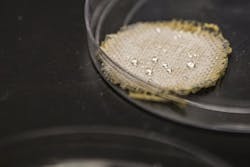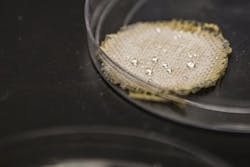Spiky Particles Puncture Solubility Limits
A process that modifies hydrophobic particles to disperse easily in water and hydrophilic particles to dissolve in oil could lead to more environmentally friendly paints and other oil-based applications, says a team of researchers at the University of Michigan, Ann Arbor, Mich. The technique is very versatile and controllable, they add.
The process creates microscopic spikes that make the particles repel each other more and attract each other less. The spikes also dramatically reduce the particles’ surface area, helping them to diffuse more easily.
Figure 1. A process that creates microscopic spikes on hydrophobic particles causes them to disperse in water, as well as hydrophilic particles to disperse in oil. Source: Joseph Xu, University of Michigan.
“We thought we’d made a mistake,” says Nicholas Kotov, a professor of chemical engineering at the university. “We saw these particles that are supposed to hate water dispersing in it and we thought maybe the particles weren’t hydrophobic, or maybe there was a chemical layer that was enabling them to disperse. But we double-checked everything and found that, in fact, these particles defy the conventional chemical wisdom that we all learned in high school.”
For the study, the team grew zinc oxide spikes on polystyrene microbeads to create so-called “hedgehog particles” — named for their spiky appearance. The researchers say the process can be performed on any particle and the spikes can be made from materials other than zinc oxide. Adjusting the amount of time the particles sit in various solutions while the protrusions are growing can vary the number and size of the spikes. More details on the development appear in a recent issue of Nature.
The hedgehog particles are well-suited for paints and coatings applications, where toxic volatile organic compounds (VOCs) are used to dissolve pigment, say the researchers. Pigments made from hedgehog particles could be dissolved in nontoxic carriers like water, they add.
“VOC solvents are toxic, they’re flammable, they’re expensive to handle and dispose of safely,” Kotov says. “So if you can avoid using them, there’s a significant cost savings in addition to environmental benefits.”
While low- and no-VOC coatings exist, Kotov believes hedgehog particles could provide a simpler, more versatile and less expensive way to manufacture them.
The team currently is working to expand the hedgehog particles to several other materials and sizes, and will explore other applications such as making oil dispersants and non-water-soluble prescription medications, as well as other uses in medicine.
“We demonstrated already a spray coating from water resulting in superhydrophobic surfaces. These are examples of paints with new properties that could be made on their basis,” notes Kotov.
According to the researchers, the process is easily scalable; Kotov estimates it’s possible to accomplish this within a year. However, cost reduction remains a challenge and extensive testing is needed to determine how using the spiked pigment particles might affect coating performance. In addition, while Kotov notes the current particles are robust at normal and high pH, they are not robust in acids.
“These particles can be quite amazing as catalysts,” says Kotov. “Anytime you need to dissolve an oily particle in water, there’s a potential application for hedgehog particles,” he adds. “It’s really just a matter of finding the right commercial partners. We’re only just beginning to explore the uses for these particles, and I think we’re going to see a lot of applications in the future.”

